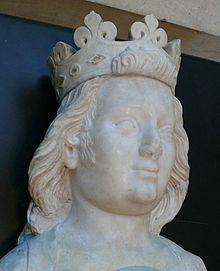Our website is made possible by displaying online advertisements to our visitors.
Please consider supporting us by disabling your ad blocker.
Charles IV of France
| Charles IV | |
|---|---|
 Gisant of Charles IV, c. 1372 | |
| King of France | |
| Reign | 3 January 1322 – 1 February 1328 |
| Coronation | 21 February 1322 |
| Predecessor | Philip V |
| Successor | Philip VI |
| King of Navarre | |
| Reign | 3 January 1322 – 1 February 1328 |
| Predecessor | Philip II |
| Successor | Joan II and Philip III |
| Born | 18/19 June 1294 Clermont, Oise, France |
| Died | 1 February 1328 (aged 33) Vincennes, France |
| Burial | |
| Spouses | |
| Issue more... | Blanche, Duchess of Orléans |
| House | Capet |
| Father | Philip IV of France |
| Mother | Joan I of Navarre |
Charles IV[note 1] (18/19 June 1294 – 1 February 1328), called the Fair (le Bel) in France and the Bald (el Calvo) in Navarre, was last king of the direct line of the House of Capet, King of France and King of Navarre (as Charles I) from 1322 to 1328. Charles was the third son of Philip IV; like his father, he was known as "the fair" or "the handsome".[2][3]
Beginning in 1323 Charles was confronted with a peasant revolt in Flanders, and in 1324 he made an unsuccessful bid to be elected Holy Roman Emperor. As Duke of Guyenne, King Edward II of England was a vassal of Charles, but he was reluctant to pay homage to another king. In retaliation, Charles conquered the Duchy of Guyenne in a conflict known as the War of Saint-Sardos (1324). In a peace agreement, Edward II accepted to swear allegiance to Charles and to pay a fine. In exchange, Guyenne was returned to Edward but with a much-reduced territory.
When Charles IV died without a male heir, the senior line of the House of Capet, descended from Philip IV, became extinct. He was succeeded in Navarre by his niece Joan II and in France by his paternal first cousin Philip of Valois. However, the dispute on the succession to the French throne between the Valois monarchs descended in male line from Charles's grandfather Philip III of France, and the English monarchs descended from Charles's sister Isabella, was a factor of the Hundred Years' War.
- ^ Brunel, Ghislain (2007). "Les cisterciens et Charles V". Société de l'histoire de France: 79. JSTOR 23408518.
- ^ Kibler, p.201.
- ^ "Charles IV (of France)". Encarta. Microsoft Corporation. 2008.
Cite error: There are <ref group=note> tags on this page, but the references will not show without a {{reflist|group=note}} template (see the help page).
Previous Page Next Page


